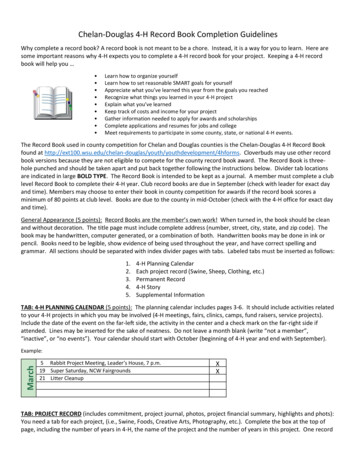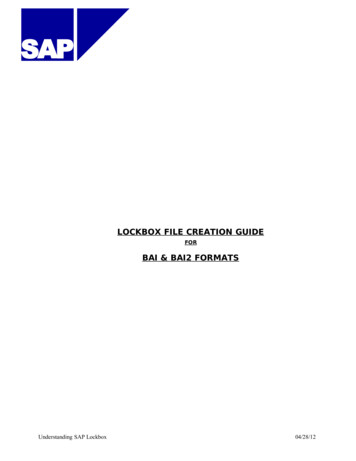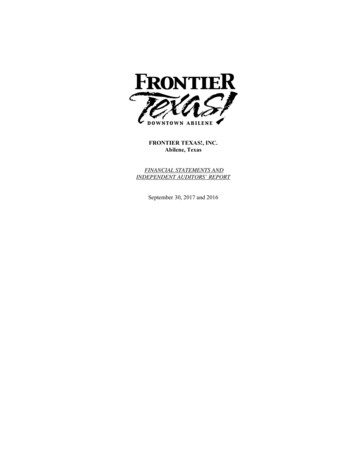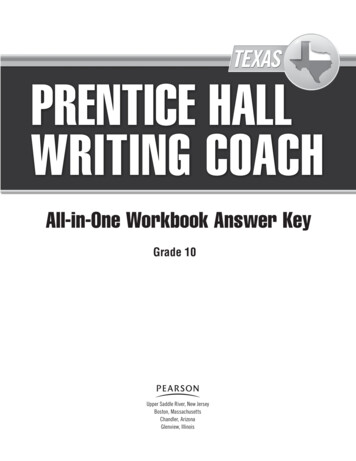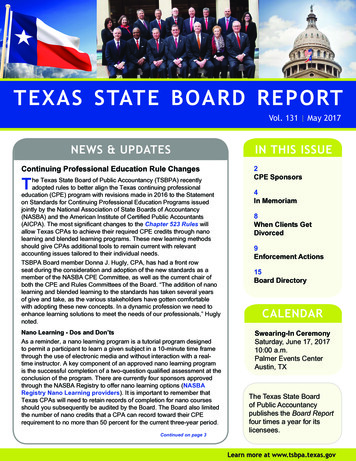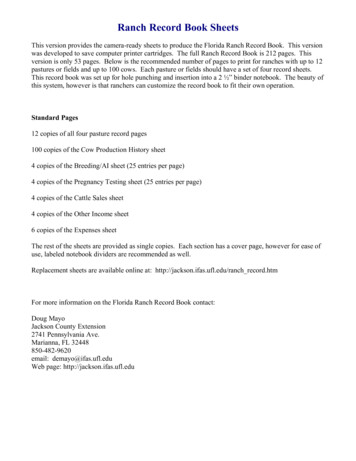
Transcription
Ranch Record Book SheetsThis version provides the camera-ready sheets to produce the Florida Ranch Record Book. This versionwas developed to save computer printer cartridges. The full Ranch Record Book is 212 pages. Thisversion is only 53 pages. Below is the recommended number of pages to print for ranches with up to 12pastures or fields and up to 100 cows. Each pasture or fields should have a set of four record sheets.This record book was set up for hole punching and insertion into a 2 ½” binder notebook. The beauty ofthis system, however is that ranchers can customize the record book to fit their own operation.Standard Pages12 copies of all four pasture record pages100 copies of the Cow Production History sheet4 copies of the Breeding/AI sheet (25 entries per page)4 copies of the Pregnancy Testing sheet (25 entries per page)4 copies of the Cattle Sales sheet4 copies of the Other Income sheet6 copies of the Expenses sheetThe rest of the sheets are provided as single copies. Each section has a cover page, however for ease ofuse, labeled notebook dividers are recommended as well.Replacement sheets are available online at: http://jackson.ifas.ufl.edu/ranch record.htmFor more information on the Florida Ranch Record Book contact:Doug MayoJackson County Extension2741 Pennsylvania Ave.Marianna, FL 32448850-482-9620email: demayo@ifas.ufl.eduWeb page: http://jackson.ifas.ufl.edu
FloridaBeef CattleRanch Record BookDoug MayoThis Record Book was developed by Doug Mayo, Jackson County Extension to enhance beef cattleranch management, meet pesticide application record requirements, meet the recommendations forCountry-of -Origin Labeling records, and to compliment the Florida Cattlemen’s Association’s WaterQuality Best Management Practice Manual.First Edition March 2004This Record Book Belongs to:
Florida Beef Cattle Ranch RecordBook Registration FormNameAddressCity, State ZIPPhoneEmail(if applicable)This Record Book can be a valuable tool to help improve the management of your beef cattleoperation. Registration is required so that updates can be sent to you. Since this is the firstedition of this publication, University of Florida Extension will be contacting you in the future foryour feed back on improving the usefulness, format and completeness of this record book.Registration forms should be mailed to:Doug Mayo, Livestock Extension AgentJackson County Extension2741 Pennsylvania Avenue, Suite 3Marianna, FL 32448The Institute of Food and Agricultural Sciences is an Equal Employment Opportunity – Affirmative Action Employer authorized to provide research,educational information and other services only to individuals and institutions that function without regard to race, color, sex, age, handicap or nationalorigin.COOPERATIVE EXTENSION WORK IN AGRICULTURE, HOME ECONOMICS, SEAGRANT AND 4-H YOUTH, STATE OF FLORIDA, IFAS,UNIVERSTIY OF FLORIDA, AND BOARDS OF COUNTY COMMISSIONERS COOPERATING.
Please Return to:City State ZIPPhone:Important Phone Numbers:Phone #Phone #Phone #Phone #Phone #Phone #Phone #Phone #Phone #Phone #Phone #Phone #For Record Book Page Refills:Contact: Doug MayoLivestock Extension AgentJackson County Extension2741 Pennsylvania AveMarianna, FL 32448850-482-9620Email: demayo@ifas.ufl.eduWeb page: http://jackson.ifas.ufl.edu/livestock.htm
About thisRecord BookThis record book was designed for field use (kept in truck), to record beef cattle andpasture records. The record sheets were designed for use in a loose-leaf binder, whichcan be customized to each individual operation. This record book does not take the placeof business accounting and was not intended as a complete record list for tax preparationor loan application.The standard record book comes with enough sheets to keep records on up to 12 fieldsand 100 cows. If additional fields are needed, simply print or copy all four pasture recordsheets (pages 10-13) for each additional field. If an operation has more than 100 cowsand heifers, additional copies of the individual cow production history sheet (page 58)should be added for each cow. The breeding and pregnancy testing sheets allow for 25cows per sheet, so copies should be made for each additional 25 cows over the standard100 head (pages 161 & 165).The individual cow production and pasture record sheets were developed to keep formultiple years. All other sheets may need to be replaced for the next year. Any recordsheets that do not apply for an operation can simply be removed. Additional recordsheets can be developed based on the needs of each operation. If individual animalrecords are not maintained, then there is no need for printing off the cow productionhistory sheets.One final suggestion, record keeping is most valuable when used for decision makingsuch as business analysis or cattle selection. In order to get the most value from therecords kept in this book, profitability and herd performance measures should bedeveloped for the year. However, with regulation and animal trace back, having a goodset of records is becoming more and more important. So keep the records to be able toprove what you have done, but also use the records to analyze performance andprofitability, to make your operation more efficient over the long haul.
Ranch Planning CalendarJanuaryFebruaryMarch
Ranch Planning CalendarAprilMayJune
Ranch Planning CalendarJulyAugustSeptember
Ranch Planning CalendarOctoberNovemberDecember
PastureRecords
Rainfall 122232425262728293031TotalTotal for YearAprYearMayJuneJulyAugSepOctNovDec
Pasture/Field RecordPasture I.D. Number of AcresCrop RecordPlanting DateCropVarietySeeding/SpriggingRate/AcreTotal AcresPlantedAreaPlantedHarvest RecordDateCropYield and Comments (# seed, # bales)
Pasture I.D. Number of AcresSoil Test RecordTest ResultsDateSampled pHTest RecommendationsP-rangeor ppmK-rangeor ppm#N/acre#P/acre#K/acreLime/acFertilizer RecordDate AppliedFertilizer TypeRate/Acre# Acres AppliedTotal AppliedPasture Improvements or RepairsDateType of Improvement Description of ImprovementArea Applied
Pasture I.D. Number of AcresPest Scouting & Control RecordDatePestScoutedPest Observed:Insect, Weeds,DiseasePest Levels:% damage, orlight, medium,or heavyCrop AffectedProduct UsedWind, Weather& FieldConditionsTreatment Method:Sprayer, nozzles,speed, pressure,gallons/acre etc.Control:Poor, Fair,Good,ExcellentPesticide Use RecordLicensed Applicator:Date andTime ofTreatmentActualApplicator (ifdifferent fromabove)License Number:BrandNameBrandNameActiveIngredientProduct EPARegistration #CropTreatedProperty Owner:RateApplied perAcreSize rvalGrazing orHayRestriction
Pasture I.D. Number of AcresGrazing RecordDate InGrassHeight InDate OutGrassHeightOutTotalGrazingDaysHerd IDNumberof Head
IndividualCow Records
Cow ID#Date ofSale orRemovalCow Production History CardCow IDReasonDescription (Breed/color)SaleWeightCow’s Sire Sire BreedSalePrice/lb.Cow’s Dam Dam BreedTotalCow’s Birth Date Weaning WeightValuePurchase Date Purchase PriceCow Production RecordCalvingYearCowAgeBull ID &BreedCalf IDCalfBirthDateWeaningCalfSexBirthWeightBCS ngWeightReplacementHeifer Keptyes/noPregnancy TestPregnantor OpenBCS orOtherRemarks
BreedingRecords
Bull Breeding Soundness Exam RecordDateBull I.D.Age of BullVeterinarianComments
Beef Cattle Gestation TableBredJan123456789Based on 283 day pregnancy10 11 12 13 14 15 16 17 18 19 20 21 22 23 24 25 26 27 28 29 30 31 JanCalve Oct10 11 12 13 14 15 16 17 18 19 20 21 22 23 24 25 26 27 28 29 30 31Bred1Feb2345678912123Mar123Calve Dec8910 11 12 13 14 15 16 17 18 19 20 21 22 23 24 25 26 27 28 29 30 31BredApr123Calve Jan8910 11 12 13 14 15 16 17 18 19 20 21 22 23 24 25 26 27 28 29 30 31BredMay1234Calve Feb78910 11 12 13 14 15 16 17 18 19 20 21 22 23 24 25 26 27 8Apr123456789 May122334455667789Jul10 11 12 13 14 15 16 17 18 19 20 21 22 23 24 25 26 27 28 29 30 31 Oct89 Aug10 11 12 13 14 15 16 17 18 19 20 21 22 23 24 25 26 27 28 29 30NovCalve Aug 10 11 12 13 14 15 16 17 18 19 20 21 22 23 24 25 26 27 28 29 30 31Bred6Sep14510 11 12 13 14 15 16 17 18 19 20 21 22 23 24 25 26 27 28 29 30Bred3459 Jun10 11 12 13 14 15 16 17 18 19 20 21 22 23 24 25 26 27 28 29 30 312348Calve JulNov2310 11 12 13 14 15 16 17 18 19 20 21 22 23 24 25 26 27 28 29 30 31 AugCalve Jun 10 11 12 13 14 15 16 17 18 19 20 21 22 23 24 25 26 27 28 29 30Bred1210 11 12 13 14 15 16 17 18 19 20 21 22 23 24 25 26 27 28 29 30 31 JulCalve May 10 11 12 13 14 15 16 17 18 19 20 21 22 23 24 25 26 27 28 29 30 31Bred1Jun23Dec10 11 12 13 14 15 16 17 18 19 20 21 22 23 24 25 26 27 28 29 301Aug79 MarBred96810 11 12 13 14 15 16 17 18 19 20 21 22 23 24 25 26 27 28 29 3085Feb10 11 12 13 14 15 16 17 18 19 20 21 22 23 24 25 26 27 28 29 30 31 May9749 NovAprCalve Apr6810 11 12 13 14 15 16 17 18 19 20 21 22 23 24 25 26 27 28 29 302577 Jan1466Jul3510 11 12 13 14 15 16 17 18 19 20 21 22 23 24 25 26 27 28 29 30 31 MarCalve Mar 10 11 12 13 14 15 16 17 18 19 20 21 22 23 24 25 26 27 28 29 30 31Bred410 11 12 13 14 15 16 17 18 19 20 21 22 23 24 25 26 27 28Calve Nov 10 11 12 13 14 15 16 17 18 19 20 21 22 23 24 25 26 27 28 29 30Bred3112233445566778Sep10 11 12 13 14 15 16 17 18 19 20 21 22 23 24 25 26 27 28 29 30 31 DecCalve Sep 9 10 11 12 13 14 15 16 17 18 19 20 21 22 23 24 25 26 27 28 29 30 1 2 3 4 5 6 7 8 9 OctDeveloped by Doug Mayo, Jackson County Extension(In leap years add one day after February 29)
Breeding or A.I. RecordstSire Est.2ndSire Est.Technician PregnancyCow Herd 1ServiceCalving ServiceCalvingStatusID IDDateDateDateDate
Pregnancy Testing RecordDateHerd I.D.Bull I.D. &BreedCow I.D.Cow AgeBCSPregnancyStatus
FeedingRecords
Supplementation RecordHerd IDDateDateStarted EndedTotal Type ofDays FeedAvg.TotalFed/Hd Fed//DayWeekTotallbs FedCost /unitTotalCost
HealthRecords
Herd Vaccination/Treatment RecordHerdDateNumberof HeadVaccine eWithdrawalDateRoute(SQ, IM,Oral,Pour-on)Injection orTreatmentSiteProcessor
Sick Cattle Treatment RecordHerd Animal Diagnosis/ID orCommentsAgeTreatment Company SerialLotLength ofWithdrawal Route(SQ, IM,& DosageNumber Number Withdrawal DateOral,Pour-on)Injection/Treatment SiteProcessor
Herd Records
Cow Herd InventoryHerd or GroupMature CowsHerdMature CowsHerdMature CowsHerdMature CowsHerdMature CowsHerdBred HeifersOpen HeifersMature BullsBulls 1-2 YearsOldYearling StockerCattleCalvesHorsesOther LivestockJan 1 BCS Spring(1-9)WorkingBCS(1-9)Pregnancy BCSTesting(1-9)Prior toCalvingBCS(1-9)
Herd or Group PerformanceGrouporHerdI.D.# CowsExposedto BullTotalCalvesBorn#CalvesDead# CalvesWorked# tal al # CowsBred# CowsOpen
Retained Ownership RecordDateShippedGroupI.D.# HeadTotalWeightAvg.Wt.DateSold# t/Lossper Head
IncomeRecords
Cattle Sales RecordDateClass ofCattleID NumberWeightPrice perPoundTotal Price
Other Income/SalesDateItem Sold orServiceProvidedCompany orIndividualDescription ofIncomeIncome perUnitTotalIncome
ExpenseRecords
Expenses/PurchasesDateItem or ServiceCompanyReason forExpenseCost/UnitTotalCost
RanchAnalysis
Cash Cost AnalysisCategoryFeedTotal PurchasedTotal nce SuppliesFuelTractormaintenance/repairsTruck maintenance/repairsTotal ExpensesCategoryNumber SoldTotal IncomeSteer CalvesHeifer CalvesCull CowsCull BullsHayServicesTotal IncomeGross Profit/Loss
Total Cattle Performance AnalysisYear:Beginning DateEnding DateBreeding# HeadXXXXXXXXXXXXXXXXXXXXCows ExposedXXXXXXXXXXXXXXXXXXXXCalvingTotal Calves BornLive CalvesDead CalvesXXXXXXXXXXXXXXXXXXXXWeaningTotal Calves WeanedSteers WeanedHeifers WeanedBulls WeanedAverage Wwt.Avg. Steer Wwt.Avg. Heifer Wwt.Avg. Bull Wwt.XXXXXXXXXXXXXXXXXXXXPregnancy CheckBred CowsOpen CowsCows CulledPregnancy Percentage # Bred Cows divided by # Cows Exposed Calving Percentage # Calves Born divided by # CowsExposed Weaning Percentage # Calves Weaned divided by # Cows Exposed Lbs. Weaned/Cow Exposed Avg. Weaning Wt. multiplied by Weaning %
UsefulInformation
Useful Extension Publications available Online from theUniversity of Florida and other UniversitiesPasturesPlanting Dates, Rates, and Methods of Agronomic CropsUF/IFAS Standardized Fertilization Recommendations forAgronomic CropsWeed Management in Pastures and RangelandInsect Management in PastureBahiagrassBermudagrass Production in FloridaAnnual RyegrassHay Production in FloridaForage Planting and Establishment MethodsSoil u/SS156Beef CattleKeep Herd Health Simple and Make it Fit the BeefCattle OperationDifferent Health Scenarios to Prepare Calves forShipping and for Receiving Yearling CattleExternal Parasites on Beef CattleNutrient Requirements of Beef CattleStrategies for Cost Effective Supplementation ofBeef CattleUsing By-Product Feeds in Beef SupplementationProgramsStrategies for Successful Development of BeefHeifersEffects of Body Condition on Productivity in BeefCattleCrossbreeding Programs for Beef Cattle in FloridaSelecting Beef s.ifas.ufl.edu/AN024Business ManagementThe Essential Financial Tools for Running a FirmCustom Rates for Farm MachineryBeef Cattle and Forage BudgetsCow-calf Production Record eef/WCR-3279/WCR-3279.pdfPesticide InformationApplication Equipment and TechniquesBroadcast Boom Sprayer Nozzle Uniformity CheckBroadcast Boom Sprayer CalibrationMaintenance, Care and Cleaning of Application ttp://edis.ifas.ufl.edu/AG006
Conversion FactorsLarry Halsey, Jefferson County ExtensionWEIGHTS28.4 grams1 ounce (oz)16 ounces1 pound (lb)1 pound0.45 kilograms2.2 pounds1 kilogram1 gallon-water8.345 poundsLINEAR MEASURES - LENGTHS1 inch2.54 centimeters12 inches1 foot30.48 centimeters36 inches3 feet1 yard1 yard0.9144 meter1 meter39.37 inches1 mile5,280 feet1 kilometer1,000 meters 0.6217 mile1/4 mile1,320 feet1.609 kilometersVOLUMES, CUBIC MEASURES1 tablespoon3 teaspoons14.8 ml0.5 fl oz1 pint2 cups16 fl oz32 Tablespoons1 quart32 ounces2 pints0.95 liters1 liter1.06 quarts1,000 ml 33.8 fl oz1 gallon4 quarts8 pints128 ounces1 gallon (liquid)231 cu inches16 cups3.8 liters1 cubic foot1728 cu in7.48 gallons (liquid)1 cubic yard27 cu feet0.77 cu meters1 acre-inch, water27,154 gallons 3,630 cubic feetA box 8 1/4" x 7" x 4" holds 1 gallonA box 16" x 12" x 11 1/4" hold 1 bushelA cylinder 6" deep x 7" diameter (3 1/2" radius) holds 1 gallon
SQUARE MEASURE1 sq foot144 square inches1 sq. yard9 sq. feet1 acre43,560 sq. ft 0.42 hectares0.836 sq. metersRATES, EQUIVALENTS AND CONVERSIONS1 ounce per square foot2,775 pounds peracre62.5 pounds per 1,000 sq ft1 ounce per square yard300 pounds per acre 7 pounds per 1,000 sq ft1 ounce per 100 sq ft27 pounds per acre1 pound per 100 sq ft436 pounds per acre 10 pounds per 1,000 sq ft0.62 pounds per 1,000 sq ft2.5 gallons per 1,000 sq ft 100 gallons per acre1 quart per 100 sq ft100 gallons per acre1 acre-inch per hour450 gallons per minute1 part per million (ppm)0.013 fl oz per 100 gallons of water1 percent solution (byweight)1.33 fl oz per gallon1 foot/second1.47 miles per hour (fps 22/15 mph)1 cup of dry fertilizer weighs approximately 1/2 pound1 quart of dry fertilizer weighs approximately 1 3/4 pounds1 quart of dolomitic limestone weighs just over 1 1/2 pounds1 pound of ryegrass will overseed about 100 sq ft (10 #/1,000 sq ft)1 pound of bahiagrass seed will cover about 750-1,000 sq ft (25-30 #/acre)1 flat of 100 bedding plants will cover:11 sq ft when spaced 4 inches apart44 sq ft when spaced 8 inches apart100 sq ft when spaced 12 inches (1 foot) apart156 sq ft when spaced 15 inches apartDimension of a Square Field:AcresDiameter of a Circular Field or Pond208.7' x 208.7'1 acre235.5' (radius 117.7')466.7' x 466.7'5 acres526.6' (radius 263.3')660.0' x 660.0'10 acres744.7' (radius 372.4')933.3' x 933.3'20 acres1,053.2' (radius 526.6')
TemperatureoF (Fahrenheit) (oC x 1.8) 32oC (Celsius) (oF - 32) x .56CEquivalentTemperatureF-40(same)-400Water Freezes3216(reciprocals)6120-25Comfortable Room Temp68-7737Human Body99100Water Boils212DILUTION RATESLIQUID MEASUREapproximate conversion ratesAmount per 100 gallons Amount per gallon1/4 pint1/4 tsp1 pint1 tsp1 quart2 tsp1 gallon2.5 Tbsp (1 fl oz)2 gallons5 Tbsp (2.5 fl oz)4 gallons1/3 pint (5 fl oz)10 gallons3/4 pint (13 fl oz)DRY WEIGHT MEASUREapproximate conversion ratesAmount per 100 gallonsAmount per gallon1/2 pound1/12 oz1 pound1/6 oz2 pounds1/3 oz3 pounds1/2 oz5 pounds3/4 oz
Number of Plants Required for an Area of:Spacing(inches)10sq ft15sq ft25sq ft50sq ft100sq ft5" x 6"48721202404805" x 8"3654901803606" x 6"40601002004006" x 8"3045751503008" x 8"22335611222510" x 10"1422367214412" x 12"1015255010015" x 8"40"48"60"72"Distance to Equal1 Acre1/100 ALenght for 1/100Acre1/1000 A246Rows Rows s per hourEquivalentTravel Rate1 mph2 mph3 mph4 mph5 mph6 mph Ft / Minute881762643524405285 min41 sec3 min47 sec2 min50 sec2 min16 sec1 min54 sec 1000 inch/ min & sec11 min22 sec
In-RowSpacing(inches )Thousands of Plants per Acre at Row Widths reviations (in alphabetical order)A acreatm atmospheresbu bushelC cups C Degrees Celciuscc cubic centimeterscm centimetercm2 square centimeters F Degrees Fahrenheitfl oz fluid ouncesft footft2 square feetg gramgal gallonha hectareHg mercuryhr hourin inchin2 square inchesin3 cubic inches K Degrees Kelvinkg kilogramkm kilometerKpa kilopascalsL literlb poundm meterm2 square metersmi milemin minuteml millilitermm millimetermph miles per houroz ouncepsi pounds per square inchpt pintqt quart R Degrees Rankinsec secondsq squaretbsp tablespoontsp teaspoonyd yardyd2 square yards
Body Condition Scoring Reference GuideWilliam E. Kunkle, Robert S. Sand, Owen Rae, and Doug MayoGood reproductive performance requires a Body ConditionScore (BCS) of 5 or higher at calving and through breeding.Proper stocking rates, a good mineral supplementationprogram, and timely use of protein supplements offer themost potential for economically improving body conditionand pregnancy rates. Separating cows by condition atpregnancy testing or two to three months prior to calvingand feeding both groups to calve in BCS 5 or above willmaintain high reproductive performance while holdingsupplemental feed costs to a minimum. The routine use ofBCS in each herd will provide needed information tomanage the cow herd for a high calf crop and profitability.Key areas to observe fat cover forbody condition scoring.Description of Body Condition Scores (BCS)BCS 1—Emaciated - Bone structure of shoulder, ribs, back, hooks and pins sharp to touch and easilyvisible. Little evidence of fat deposits or muscling.BCS 2—Very Thin - Little evidence of fat deposits but some muscling in hindquarters. The spinousprocesses feel sharp to the touch and are easily seen, with space between them.BCS 3—Thin - Beginning of fat cover over the loin, back and foreribs. Backbone still highly visible.Processes of the spine can be identified individually by touch and may still be visible. Spaces betweenthe processes are less pronounced.BCS 4—Borderline - Foreribs not noticeable; 12th and 13th ribs still noticeable to the eye,particularly in cattle with a big spring of rib and ribs wide apart. The transverse spinous processes canbe identified only by palpation (with slight pressure) to feel rounded rather than sharp. Full butstraightness of muscling in the hindquarters.BCS 5—Moderate - 12th and 13th ribs not visible to the eye unless animal has been shrunk. Thetransverse spinous processes can only be felt with firm pressure to feel rounded - not noticeable to theeye. Spaces between the processes not visible and only distinguishable with firm pressure. Areas oneach side of the tail head are fairly well filled but not mounded.BCS 6—Fleshy - Ribs fully covered, not noticeable to the eye. Hindquarters plump and full.Noticeable sponginess to covering of foreribs and on each side of the tail head. Firm pressure nowrequired to feel transverse processes.BCS 7—Smooth - Ends of the spinous processes can only be felt with very firm pressure. Spacesbetween processes can barely be distinguished at all. Abundant fat cover on either side of tail headwith some patchiness evident.BCS 8—Fat - Animal taking on a smooth, blocky appearance; bone structure disappearing from sight.Fat cover thick and spongy with patchiness likely.BCS 9—Very Fat - Bone structure not seen or easily felt. Tail head buried in fat. Animal's mobilitymay actually be impaired by excess amount of fat.
Body Condition Score ExamplesBCS 2BCS 3BCS 4BCS 5BCS 6BCS 7Body condition affects the amount and type of supplements needed during the winter. Fat cowscan lose body reserves, and 1 to 2 pounds per head per day of a 30 to 40 percent proteinsupplement plus minerals and vitamins is sufficient to maintain adequate body condition in manysituations. In contrast, thin cows have little body reserves and often need 4 to 6 pounds per headper day of a high-energy supplement with 12 to 16 percent protein plus minerals and vitamins toavoid significant flesh losses and reductions in pregnancy rates.
County Extension Office Contact InformationAlachua County(352) 955-2402e-mailalachua@ifas.ufl.eduColumbia County(386) 752-5384e-mailcolumbia@ifas.ufl.eduHamilton County(386) 792-1276e-mailhamilton@ifas.ufl.eduLafayette County(386) 294-1279e-maillafayette@ifas.ufl.eduBaker County(904) 259-3520e-mailbaker@ifas.ufl.eduDesoto County(863) 993-4846e-maildesoto@ifas.ufl.eduHardee County(863) 773-2164e-mailhardee@ifas.ufl.eduLake County(352) 343-4101e-mail lake@ifas.ufl.eduBay County(850) 784-6105e-mail bay@ifas.ufl.eduDixie County(352) 498-1237e-maildixie@ifas.ufl.eduHendry County(863) 674-4092e-mailhendry@ifas.ufl.eduDuval County(904) 387-8850e-mailduval@ifas.ufl.eduHernando County(352) 754-4433e-mailhernando@ifas.ufl.eduEscambia County(850) 475-5230e-mailescambia@ifas.ufl.eduHighlands County(863) 402-6540e-mailhighlands@ifas.ufl.eduFlagler County(386) 437-7464e-mailflagler@ifas.ufl.eduHillsborough County(813) 744-5519e-mailhillsborough@ifas.ufl.eduMadison County(850) 973-4138e-mailmadison@ifas.ufl.eduHolmes County(850) 547-1108e-mailholmes@ifas.ufl.eduManatee County(941) 722-4524emailmanatee@ifas.ufl.eduIndian River County(772) 770-5030e-mailindian@ifas.ufl.eduMarion County(352) 620-3440e-mailmarion@ifas.ufl.eduJackson County(850) 482-9620e-mailjackson@ifas.ufl.eduMartin County(772) lBradford County(904) 966-6224e-mailbradford@ifas.ufl.eduBrevard County(321) 633-1702e-mailbrevard@ifas.ufl.eduBroward County(954) 370-3725e-mailbroward@ifas.ufl.eduCalhoun County(850) 674-8323e-mailcalhoun@ifas.ufl.eduCharlotte County(941) 764-4340e-mailcharlotte@ifas.ufl.eduCitrus County(352) 726-2141e-mailcitrus@ifas.ufl.eduClay County(904) 284-6355e-mail clay@ifas.ufl.eduCollier County(239) 353-4244e-mailcollier@ifas.ufl.eduFranklin County(850) 653-9337e-mailfranklin@ifas.ufl.eduGadsden County(850) 875-7255e-mailgadsden@ifas.ufl.eduGilchrist County(352) 463-3174e-mailgilchrist@ifas.ufl.eduGlades County(863) 946-0244e-mailglades@ifas.ufl.eduGulf County(850) 639-3200e-mail gulf@ifas.ufl.eduJefferson County(850) 342-0187e-mailjefferson@ifas.ufl.eduLee County(239) 461-7510e-mail lee@ifas.ufl.eduLeon County(850) 487-3003e-mail leon@ifas.ufl.eduLevy County(352) 486-5131e-mail levy@ifas.ufl.eduLiberty County(850) 643-2229e-mailliberty@ifas.ufl.eduMiami-Dade County(305) 248-3311e-maildade@ifas.ufl.edu
Monroe County(305) 292-4501e-mailmonroe@ifas.ufl.eduPalm Beach County(561) 233-1712e-mailpalmbeach@ifas.ufl.eduNassau County(904) 879-1019e-mailnassau@ifas.ufl.eduPasco County(352) 521-4288e-mailpasco@ifas.ufl.eduOkaloosa County(850) 689-5850e-mailokaloosa@ifas.ufl.eduPinellas County(727) 582-2100e-mailpinellas@ifas.ufl.eduOkeechobee County(863) 763-6469e-mailokeechobee@ifas.ufl.eduPolk County(863) 519-8677e-mail polk@ifas.ufl.eduOrange County(407) 836-7570e-mailorange@ifas.ufl.eduOsceola County(321) 697-3000e-mailosceola@ifas.ufl.eduPutnam County(386) 329-0318e-mailputnam@ifas.ufl.eduSt. Johns County(904) 824-4564e-mailstjohns@ifas.ufl.eduSt. Lucie County(772) 462-1660e-mailstlucie@ifas.ufl.eduSanta Rosa County(850) 623-3868e-mail countyextension@co.santarosa.fl.usSarasota County(941) 861-9800e-mailsarasota@ifas.ufl.eduSeminole County(407) 665-5556e-mailseminole@ifas.ufl.eduSeminole Tribe(863) 763-5020 ext. 115e-mailYKudo@mail.ifas.ufl.eduSumter County(352) 793-2728e-mailsumter@ifas.ufl.eduSuwannee County(386) 362-2771e-mailsuwannee@ifas.ufl.eduTaylor County(850) 838-3508e-mailtaylor@ifas.ufl.eduUnion County(386) 496-2321e-mailunion@ifas.ufl.eduVolusia County(386) 822-5778e-mailvolusia@ifas.ufl.eduWakulla County(850) 926-3931e-mailwakulla@ifas.ufl.eduWalton County(850) 892-8172e-mailwalton@ifas.ufl.eduWashington County(850) 638-6180e-mailwashington@ifas.ufl.edu
Record Book This record book was designed for field use (kept in truck), to record beef cattle and pasture records. The record sheets were designed for use in a loose-leaf binder, which can be customized to each individual operation.
